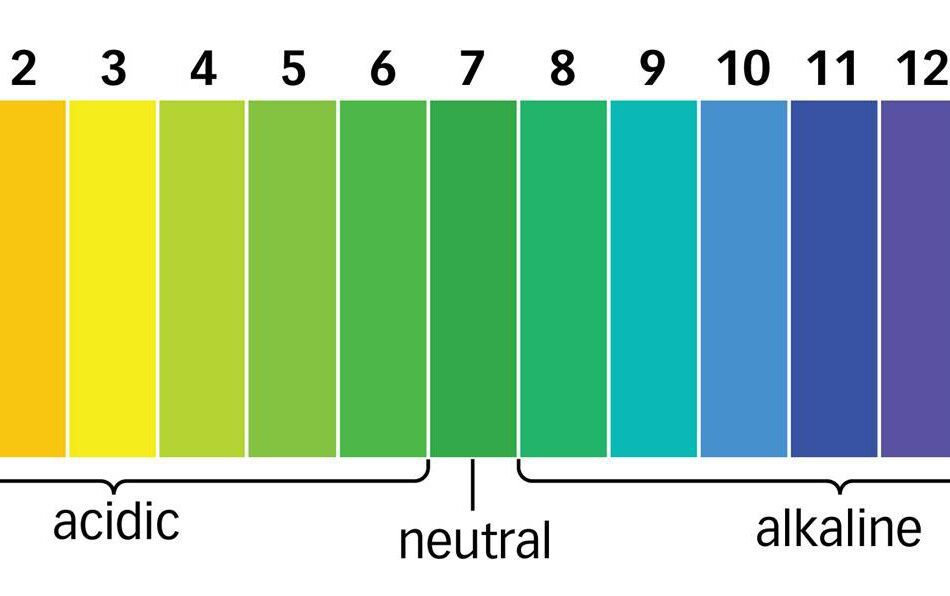
The ideal pH level in both swimming pools and hot tubs is 7.4 to 7.6. This is the level where water is most comfortable for swimmers while also maximizing chlorine’s sanitizing ability.
When you dreamed of owning your own pool, you probably imagined you’d just have to add in some chlorine periodically, and it would be up and running. The reality of pool maintenance is a bit more complex!
Your pool water is a mixture of chemicals that interact in sometimes-mysterious ways. The acidity and alkalinity of your pool water can change because of high water temperatures, rainwater, and due to the addition of chlorine or other chemicals. When something goes wrong with your pool, it is often the chemical composition of your water that is to blame.
That’s why we will be answering the most common muriatic acid pool questions. Muriatic acid is one of the most versatile pool chemicals in your pool chemistry toolkit.
DAD JOKE: If your pool’s pH and alkalinity levels are too high, your water is just so basic. (Groan.)
One of the most critical levels to check in your pool is the pH balance. If your pH is higher than 7.8, your pool water is too alkaline. High water alkalinity can cause cloudy water, scaling, and calcium buildup. You may also see an increase in algae blooms if your pH and alkalinity levels are too high.
High alkalinity can decrease on its own over time, and it may be tempting to ignore it. But wait too long, and the damage to your pool surfaces, filter, and circulation systems can be critical. It is likely your sanitizer will have to work harder as well, and you will end up adding even more chlorine. Muriatic acid is a cheap, effective solution to lower your pool’s pH and alkalinity.
You may have seen muriatic acid in your local hardware store. It is commonly used to clean and lower pH levels on brick walls to help paint stick better. The muriatic acid in pools is similar but has a lower concentration of hydrogen chloride, and it is often used to deep-clean and break down the residue found in pool filters. It can also be used to scrub the walls of your pool if you notice excessive algae growth you can’t seem to get rid of.
This same muriatic acid can be added directly to your pool to lower the pH and alkalinity levels when they get too high. Here’s a 5-point, step-by-step guide for lowering your pool’s total alkalinity using muriatic acid:
Testing your water with a test kit is always the first step before adding any chemicals to your swimming pool water. You need to know how many gallons of water your pool holds, as well as the pH and alkalinity levels. With the handy pool calculator app for desktop, iOS, and Android, you can easily monitor and track your pool chemistry before adding muriatic acid or anything else.
There is a debate over whether to keep your pump on or off while you add muriatic acid to your pool water. The argument for shutting off your pump while adding muriatic acid is that the pump will not only circulate the chemicals but will also add oxygen, which can amplify the muriatic acid’s effect on your pH levels. This rapid shift may make it harder to accurately target your desired pH. The argument for keeping your pump running is the fact that muriatic acid is a strong chemical that can eat away at your pool floor if left too long. It’s ultimately your call, so consider the costs and benefits of each approach.
Whether you keep your pump running or turn it off, remember: Muriatic acid is a dangerous substance. Exercise serious caution and make sure you are wearing protective gear before proceeding. What protective gear do you need?
Begin by diluting the muriatic acid in a water bucket to make it easier to handle and less dangerous before adding it to your pool water. Add water to the plastic bucket first, before you add the muriatic acid at a ratio of 10:1. Adding the water first will avoid a chemical reaction between the undiluted acid and the plastic bucket.

The ideal pH level in both swimming pools and hot tubs is 7.4 to 7.6. This is the level where water is most comfortable for swimmers while also maximizing chlorine’s sanitizing ability.
Once the bucket is full, pour the entire contents of the bucket into the deep end of your pool. If you are experiencing high total alkalinity and high pH, you can walk around the pool and pour in the contents. Rinse the bucket entirely after you’ve emptied it, and do not add any other chemicals to that bucket, or you may risk injury.
Now it’s time to let the muriatic acid do its work. At this point, you can play it safe by running your pump for at least half an hour to stop the acid from settling on your pool floor. If you would rather keep your pump off, make sure to brush the pool floor continuously to prevent damage.
After at least four hours, you can test your water again for pH and alkalinity levels. You may have to repeat this process a few times to get your levels right.
Muriatic acid is as essential to keeping your pool water as clean and healthy as chlorine. It is also a necessary chemical when trying to keep the pH levels at the optimal range for your chlorine sanitizer to work. That’s why it’s essential to add the right amount of muriatic acid to your pool. If you do add too much muriatic acid, your pH levels can dip dangerously low, and your pool water can cause rashes and eye irritation. Low levels of pH can also damage metals in your pool like ladders, railings, screws, bolts, and other important equipment.
If you add too much muriatic acid and your pH level drops to a below optimum level, you may need to add sodium carbonate or soda ash to rebalance your pH level. This back-and-forth use of chemicals and change in pH levels can be frustrating and costly, which is why you should avoid adding too much muriatic acid in the first place. Going slow and steady is the safest option.
Adding muriatic acid directly to your pool can create a hot spot of acid that can potentially burn or irritate the skin if you swim too early. Even diluted muriatic acid can potentially cause harm. Muriatic acid contains hydrochloric acid concentration levels between 28 to 35 percent. Swimming in hydrochloric acid can irritate your eyes and respiratory tract, causing coughing, hoarseness, and inflammation of the respiratory tract.
Some people will tell you that it’s safe to swim just 30 minutes after adding muriatic acid to your pool water. But we recommend playing it safe by waiting three to four hours and testing your water before swimming in your pool. The Pool Calculator app for desktop, iOS, and Android will help you understand the amount of pool chemicals needed to balance your pool based on its temperature, volume (gallons), and surface.
Muriatic acid is a popular solution because of its cost and availability, but there are other options you can use if you are concerned about safety. Pool algaecide, sodium bisulfate, sodium dichlor, and trichlor are other options that may help balance your pool’s pH levels.
Sodium bisulfate comes in a crystal form and can be added directly to the deep end of your pool. This substance is safer to handle and store than muriatic acid but can take over 24 hours to work, compared to just four hours for muriatic acid.
Sodium dichlor is a tablet form of chlorine sanitizer with a pH range of 6.8 to 7.0 that can be diluted and added to your pool water. Trichlor tablets are another option with a very low pH level (2.8 to 3.0). Trichlor also contains cyanuric acid. These both can be added to your pool water in a floating feeder, but never add them to your pool skimmer, or they may cause damage.
Most experts agree that muriatic acid is the best option to lower the pH and alkalinity levels of your pool water. You can also use it to clean tiles, remove stains, dissolve calcium deposits, and kill any mold and algae leftover in your pool at the end of the year.
Of course, if you don’t know the proper way to use muriatic acid, you can do more harm than good! That’s why it’s important to read up, use proper safety gear, and (as always) check your pool water alkalinity levels with a test kit before and after adding muriatic acid. To make testing and monitoring your pool chemistry a breeze, get the Pool Calculator app and get started in minutes.
https://www.swimuniversity.com/muriatic-acid
https://poolcareguy.com/muriatic-acid-pool
https://www.poolcleanerblog.com/muriatic-acid-for-pools
https://www.intheswim.com/eGuides/when-to-swim-after-adding-pool-chemicals
https://www.hunker.com/13419283/how-long-after-adding-muriatic-acid-can-you-swim
https://www.gardenguides.com/13418393-alternatives-to-muriatic-acid-for-swimming-pools.html
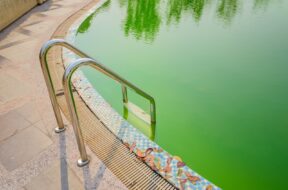
Want to learn more about algaecide? Read on to find out when to add algaecide to your pool maintenance routine and other helpful tips.
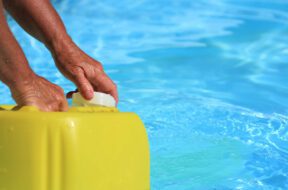
In this quick guide, we’ll answer the question “can you over shock a pool” and unveil the factors to consider when shocking a pool.
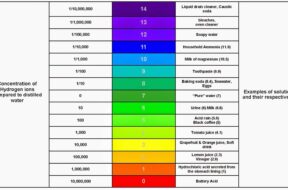
Maintaining both pH and total alkalinity in your swimming pool is important for keeping your pool properly sanitized and non-corrosive. Total alkalinity is to pH what cyanuric acid is to free chlorine. Total alkalinity stabilizes pH levels. The ideal pool pH level is 7.4 to 7.6. The ideal total alkalinity level is 80 to 120 ppm.
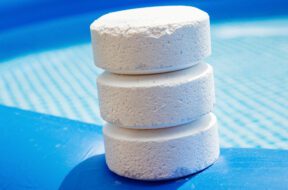
The Association of Pool and Spa Professionals recommends free chlorine levels for both swimming pools and hot tubs be kept between 2.0 and 4.0 ppm. However, the Center for Disease Control recommends free chlorine stay above 1 ppm in pools and 3 ppm in hot tubs.